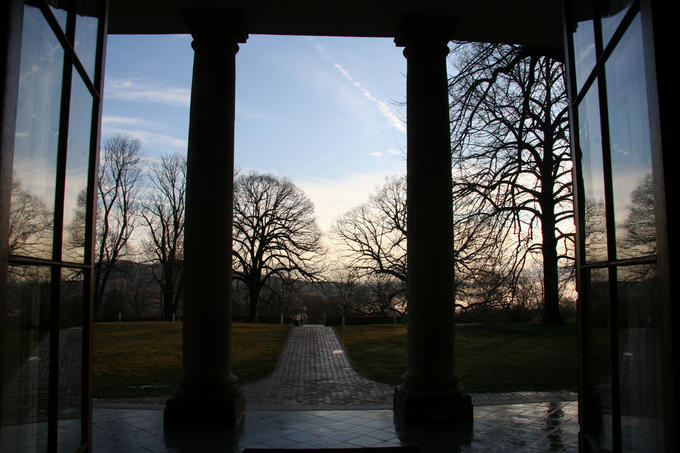Mornings in Monticello
I love watching guests on tours at Monticello when a clock strikes. Why? The look of surprise, then inevitably, a whisper, “wow, the clock still works,” and even better, “it’s nearly on time.” It makes me wonder: how many people know what goes on inside a museum like Monticello before the doors open to visitors?
If you’ve ever wondered about this yourself, you’re in luck. I am an expert at Monticello before hours. I am a Curatorial Assistant here at the Thomas Jefferson Foundation. My job is to assist the Collections Manager in the care of the historic collection. More simply put: we take care of the stuff in the house—all the stuff that belonged to Thomas Jefferson, as well as the pieces in the collection that belonged to his direct family.
My day begins at Monticello between 5:30 and 6:00 am. Yes, AM. As a Curatorial Assistant once you get over the shock of the time of day, you begin to appreciate that you are one of very few people who have the opportunity to experience Monticello alone. (Well, nearly alone. Monticello always has a dedicated group of security officers hovering just out of sight at all times.) I like to begin by doing my own walk through of the house. I have been in this position for five years, and it is easy to forget that I am at Monticello. But it often strikes me, early in the silence of the morning, as the sun begins to peak up over the distant mountains, and splash light through the trees onto the Entrance Hall grass green floor cloth—I’m at Monticello. Surrounded by art and architecture and history, and I have my own moment to enjoy it.
Ok, back to work— like a Harry Potter house elf, I am rarely seen. During my morning walk through, from which I digressed, I look around, making sure that everything is exactly where I left it the day before, and in the same, albeit somewhat dustier, condition. Monticello is often visited by thousands of visitors in a day, and even with the best of intentions, things happen. Rarely, objects might get in the way of an accident and become victims themselves. More often though, damage to objects happens because they’re old. Sometimes old repairs fail, or a crack appears in an object, simply because of the stress of holding itself up. Because of this, I know everything on display in meticulous detail. With a keen eye, attention to detail, and a quick acting staff, damage and the need for repair/conservation can be mitigated.
Remember that dust I mentioned? It can’t stay there. The next morning task is taking a soft, natural fiber brush and a dust rag around the house. When I was young, my Saturday morning chore was dusting. There are two things my mother never told me: 1. Aerosol dust removers are bad, 2. Dust is abrasive. First, we try to stay away from spraying anything in the historic interior. More interestingly (at least to me) is that dust on some materials, like brass, can actually scratch its surface. Remember back to your house tour of Monticello, or take a look at photographs of the interior. Dusting Monticello takes a long time. And, yes, we do miss spots occasionally—we are not actually house elves.
By far my favorite charge is winding the mantle clocks. Each clock has its own key, and its own feel. When I started my position I had nightmares about breaking one of the clocks. Experience has taught me exactly what each clock feels like as it is wound, and what is required to balance each clock. The clocks are tricky, and temperamental. One runs fast, one slow, one runs perfectly on time, but only when it wants to. Perhaps that is why I like them: clocks are a tedious challenge.
When tours begin, the house has been inventoried and dusted and care has been taken to assure that its contents are safe for another day. Usually by then, I am a good 3 hours into my day, and off to my office for my second cup of coffee.
Taking care of such a historic residence is only worth it if it is shared. Please, come visit and enjoy Monticello. And if, while you are touring, you hear a clock strike, be forgiving if it isn’t exactly on time, it is over 200 years old, after all.



